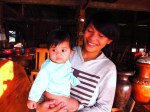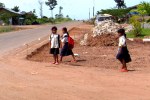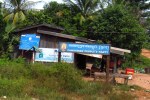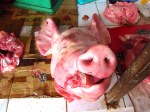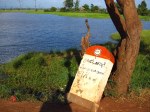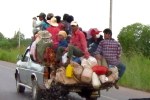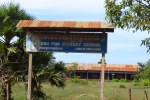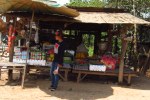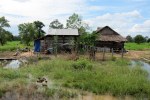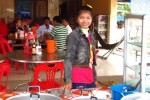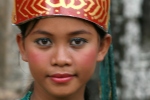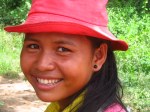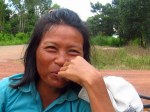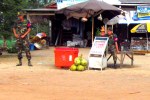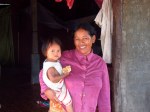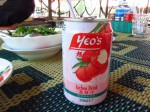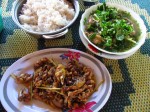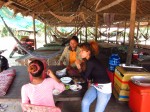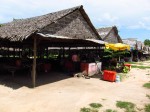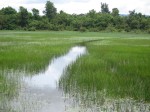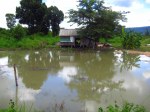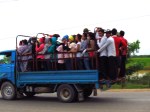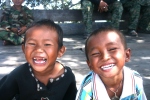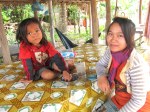Cambodia is almost a forgotten country. Almost, but not quite. The glories of Angkor and the disaster years of the Khmer Rouge have kept it in the international spotlight. The horrors that have befallen Cambodia are incomprehensible. Cambodia is a truly wonderful place inhabited by beautiful endlessly friendly people that has endured 50 years of awful Governments. No-one deserves such governments, but particularly not the Cambodians.
The wars, the genocide, the vast bombings by the US during the Vietnam War, the landmines and the theft of massive amounts of foreign aid money by Hun Sen, his family and cronies, have left most of the rural population very poor.
The world now knows about Pol Pot and his maniacal rule for 4 years in which almost 2 million people, a quarter of its then population, were murdered, especially those who were the best educated. The ruinous governments continue. Its Prime Minister for the past 26 years has been Hun Sen a former member of Pol Pot’s Khmer Rouge team. He is widely accused of being massively corrupt, and has been accused by Amnesty Internation of having been in charge when his political opponents were murdered in 1997. The children of his cronies flaunt their staggering wealth in this poor country, being driven by their chaffeurs round Phnom Penh in black Hummers with armed guards. Nightclubs which they frequent are not safe to visit.
Hun Sen’s party is called the Cambodian People’s Party. CPP offices are in every village, even the smallest. Invariably they are the most significant buildings in the town. It’s reasonable to ask why the money is not put into the local schools and hospitals.
The Buddhist population of about 15 million, 80% of whom live in rural areas, rely largely on rice growing and other agriculture. Historically poor education levels and inadequate infrastructure, despite major efforts by foreign aid donors, make it difficult for anyone in the provinces to improve their lot. Half the population is under the age of 22 as a result of the wars.
Virtually all the population is Khmer, with a small population of Vietnamese and Chinese. They call the country “Kampuchea”, but realise that westerners call it Cambodia.
Cambodia receives huge amounts of foreign aid, but only a small part reaches the intended destinations. The view of the donors is that at least some does gets through, even though a lot is syphoned off, and that if they turn off the tap there will be none at all. Meanwhile the inner circle gets richer and richer, and the lot of the 80% of the population that has no electrictity or toilets or clean water stays much the same.
According to the CIA World Book, Cambodia has the lowest ratio of hospital beds per head of population of any country – 0.1 per 1000. Over 5% of children born will not live to be 5 years old. Five per cent of pregnant women die during childbirth. There are only 2 doctors per 10,000 people, compared to 15 in Singapore and 6 even in Vietnam. These figures include the private health system which is far better-resourced than the public system. Most health professionals do not earn enough at public hospitals to enable them to live, so they have to supplement their incomes by working second jobs, taking bribes to give priority treatment, or leaving the public system to work for a private hospital or clinic.
These figures are even worse than those for Laos and Myanmar, and it is difficult to believe that anywhere could be worse than those countries. The figures are far worse in rural areas than in Phnom Penh. The number of health professionals per head of population in rural areas is less than 10% of the number in Phnom Penh. Only 50% of women use contraception. Life expectancy is only 60 years.
Cambodia has one of the lowest expenditures on education. Less than 20% of the rural population has access to any level of developed sanitation. Many people in rural areas have no electricity, which means that they do not have a water pump and that leads to many problems including disease. School children, even the very young ones, have to walk many kilometres to and from school along the side of the road. Rice workers do back breaking work in very hot weather and get paid $4 a day.
Yet the people are eternally smiling and friendly. It seems to me that their virtue of passiveness is also their weakness. They have not been prepared to face up to those who have run the country since 1975. Their history is such a mess that the US, China and the UK continued to support Pol Pot for many years after he was overthrown, in some cases until the 1990s, because he was the enemy of Vietnam, which was still seen as being the enemy of the US and China. How could anyone have supported Pol Pot?
I have been fortunate to get to know a guide, Siya, his lovely wife Sophap and their friends Yann and Sokim. Young kids, 26 or 27, who, in the typical Cambodian way, are wonderful company, great fun, and determined to find a way out of the financial hardship which was their history, and to enjoy life while they do it. Sokim has her own website design company and owns a guest house in Siem Reap. Siya knows everyone in Siem Reap. He wants to buy how own care and build up a tour guide business. He would be sensational. Yann teaches English at Siem Reap high school, for 15-18 year olds. If you need a guide and driver in Siem Reap, and want someone to talk to about its recent history, politics, society and anything else, Siya is your man.
- Khmer mother and baby
- Schoolkids walking home
- The CPP is everywhere
- Market Anglong Veng
- Lake at Anglong Veng
- Restful scene at Anglong Veng. This place was at the heart of the civil war.
- The local bus
- Rural school founded by foreign donors – looks like more are needed
- Local general store
- Home sweet home
- Waitress, Kralanh
- Sokim (“call me Kim”)
- Siya and Sophap
- Every morning the monks knock on doors, receive small gifts of rice or money, and give blessings
- A country of beautiful Khmer girls
- Army selling coconuts at roadside stall
- Khmer grandmother at home in the middle of nowhere
- …. and washed down with a nice cold lychee drink.
- Chicken and lemongrass – yum.
- The cooks and their mother, and the rows of hammocks above the eating tables. Eat then sleep.
- Rural restaurant at Phnom Tamao
- Rice fields
- Home with a swimming pool.
- Petrol atation
- Being driven home from work. 60 people on this small truck.
- Khmer mum and daughter at roadside stall

